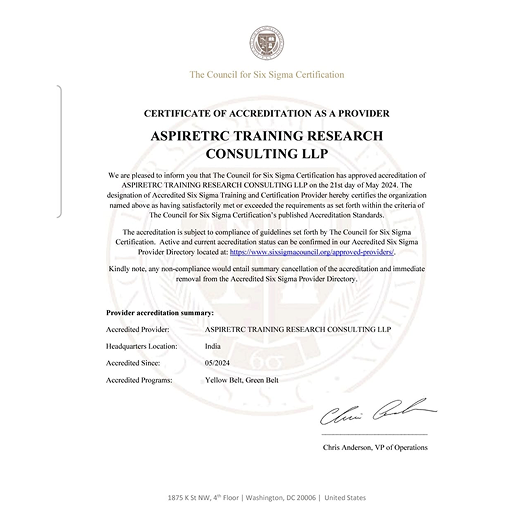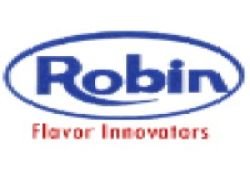Aspire Training Research Consulting
Six Sigma Course
 International Approved Centre
International Approved Centre

Get a Certification in the Six Sigma Belt Certification Course
in India to Improve Your Business.
Six Sigma courses teach how to apply the Six Sigma methodology, a data-driven approach to improving business processes by reducing errors and increasing efficiency. As a leading provider of Six Sigma training, Aspire Training Research Consulting focuses on minimizing defects throughout the process to achieve better results. The Six Sigma methodology employs various tools and techniques to analyze and improve processes, leading to higher customer satisfaction and increased profitability.
Six Sigma methodology employs a range of tools and techniques to analyse and enhance processes, ultimately improving customer satisfaction and profitability. It is commonly used to improve quality and reduce defects in business processes, aiming for near-perfect outcomes. The term “Six Sigma” refers to six standard deviations in a data set, indicating that a defect should only occur after six such deviations.

Why Choose Aspire Training Research Consulting for your
Six Sigma Belt Certification Course in India?
- Global accreditation and recognition: We provide courses that are accredited by the Council for Six Sigma Certification (CSSC).
- Comprehensive curriculum: We cover all the fundamental concepts to advanced statistical analysis of both green belt and yellow belt courses with real-world application through DMAIC methodology, process improvement techniques, and business analytics.
- Practical-oriented and industry-relevant training: We opt for practical training rather than a theoretical way of teaching.
- Flexible learning options: Flexible evening training sessions from 7 PM to 10 PM
- Open door to a wide range of opportunities: After the course, you will have a lot of job opportunities, offering higher salaries and growth opportunities.
- Expert mentors and supportive learning environment:With years of expertise and experience, our mentors will provide personalized guidance and mentorship, ensuring each of our learners gains the knowledge they need to stand out in this field.
Choosing Aspire Training Research Consulting means investing in your career and future by gaining valuable insights and analytics that unlock opportunities for professional growth and business success.
Six Sigma Course Schedule

Learn About the Green Belt Course
The Six Sigma Green Belt course is an intermediate certification designed to equip individuals with the knowledge and skills to support process improvement initiatives and lead smaller projects. It emphasizes the use of the DMAIC methodology (Define, Measure, Analyze, Improve and Control) to improve quality and efficiency.
Council for Six Sigma Certification (CSSC)
Accredited Green Belt Certified Course
The facility will carry out projects across various sectors including retail, e-commerce, web and social media, banking, supply chain, healthcare retail, insurance, entrepreneurship, finance and more. Six Sigma is a structured, data-driven approach aimed at improving business processes by identifying and eliminating defects, reducing variation and building overall quality. Based on statistical principles and established quality control methods, Six Sigma enables organizations to optimize operations, reduce costs and provide higher quality products and services to their customers.
The approach originated from practical challenges in manufacturing, where experts used statistical analysis to address ongoing production problems. They found that by concentrating on data and process performance, they could speed up production, reduce waste, improve quality and increase customer satisfaction.

Today, Six Sigma is widely recognized across industries as an effective tool for continuous improvement. It focuses on disciplined problem-solving, measurable outcomes and a strong dedication to excellence. When applied correctly, it not only boosts operational efficiency but also improves a company’s competitive advantage.
As more businesses worldwide adopt Six Sigma, it has the potential to become a global standard for quality and efficiency. In a time when consistency, customer loyalty and productivity are crucial, Six Sigma provides a clear path to long-term, sustainable growth.
What will you learn?
COURSE CONTENT—GREEN BELT
UNIT 1: INTRODUCTION TO SIX SIGMA
- CHAPTER 1: What is Six Sigma?
- CHAPTER 2: Six Sigma History and Application
- CHAPTER 3: Other process improvements and quality methods
- CHAPTER 4: Lean concepts
- CHAPTER 5: Basic Six Sigma Concepts
- CHAPTER 6: Approaching the problems
UNIT 2: PROJECTS AND PROCEDURES
- CHAPTER 1: What is a process?
- CHAPTER 2: Quality
- CHAPTER 3: Selecting the right projects
- CHAPTER 4: Basic Six Sigma Team Management
- CHAPTER 5: Introduction to DMAIC and DMADV

UNIT 3: ADVANCED DMAIC
- CHAPTER 1: Define
- CHAPTER 2: Measure
- CHAPTER 3: Analyze
- CHAPTER 4: Improve
- CHAPTER 5: Control
UNIT 4: UNIT STATISTICS
- CHAPTER 1: Intermediate Graphical Analysis
- CHAPTER 2: Normal Probability Distributions
- CHAPTER 3: Correlation and Regression
- CHAPTER 4: Intermediate Statistics
- CHAPTER 5: Intermediate Graphical Analysis
- CHAPTER 6: Hypothesis Testing
- CHAPTER 7: Sample size
- CHAPTER 8: Advanced control charts
- CHAPTER 9: Applying Statistics to Business
Applications through Six Sigma
PRE-REQUISITES:
Be enthusiastic to achieve the world's premium strategy for problem-solving.
Certification upon Completion: Earn a recognized Green Belt certification that validates your skills and expertise in process improvement.
Know More About the Yellow Belt Course
The Six Sigma Yellow Belt certification equips individuals with a foundational understanding of Six Sigma principles, focusing on the core tools and techniques used to address process-related issues within a team environment. Yellow Belts typically contribute to improvement projects at a departmental level, where the scope is limited and does not require navigating the complexities of cross-functional processes. As a result, there is generally less emphasis on broader areas such as stakeholder management, allowing Yellow Belts to concentrate on identifying inefficiencies, supporting data collection, and assisting in problem-solving within their specific teams.
Syllabus of the Six Sigma Yellow Belt Course:
Here is a general syllabus for a Six Sigma Yellow Belt course:
Introduction to Six Sigma
- 1. Definition and history of Six Sigma
- 2. Six Sigma methodology and principles
- 3. Roles and responsibilities in a Six Sigma project
Six Sigma Fundamentals
- 1. Understanding variation and its impact on processes
- 2. Process mapping and identification of key process indicators
- 3. Basic statistics and data analysis

DMAIC Methodology
- 1. Define phase: identifying problems and opportunities
- 2. Measure phase: collecting and analyzing data
- 3. Analyze phase: identifying root causes and relationships
- 4. Improve phase: generating and evaluating solutions
- 5. Control phase: implementing and sustaining improvements
Tools and Techniques
- 1. Process mapping and swimlane analysis
- 2. Cause-and-effect diagrams and fishbone analysis
- 3. Pareto analysis and histograms
- 4. Basic hypothesis testing and confidence intervals
- 5. Control charts and statistical process control
Case Studies and Group Exercises
- 1. Applying Six Sigma tools and techniques to real-world scenarios
- 2. Group exercises and discussions to reinforce learning
Benefits of Six Sigma Certification
Being certified in Six Sigma offers numerous benefits, including career advancement, higher earning potential, enhanced problem-solving skills, improved business processes, and making individuals more valuable to organizations.
For Individuals
- Career Advancement: Individuals who earn Six Sigma certification prove their expertise in quality management and process improvement so they gain advantages in employment opportunities and qualify for positions with leadership and managerial responsibilities.
- Higher Earning Potential: The skilled workforce demonstrates superior command over salaries and compensation packages because their expertise includes process improvement and quality control methods.
- Enhanced Problem-Solving Skills: Six Sigma training provides structured methods to handle complex issues through analysis and problem-solving measures, which result in better solutions.
- Improved Business Processes: Six Sigma certification enables people to master process enhancement methods that drive operational excellence through minimized waste production.
- Increased Confidence: Six Sigma certification delivers both validation of professional expertise combined with assurance about technical capabilities to handle process enhancement projects.
- Global Recognition: The worldwide acceptance of Six Sigma methodology enables certificate holders to demonstrate their value in multiple types of organizations around the world.
- Adaptability Across Industries: Six Sigma principles show compatibility with different business sectors, thus making the certification an important credential for professionals who want to transition between industries.
For Organizations
- Improved Customer Satisfaction: Quality standards improvement happens when organizations use Six Sigma to fulfill customer needs and reduce defects, which creates satisfied customers who become loyal to the brand.
- Reduced Costs: Organization cost management becomes successful under Six Sigma and enables significant efficiency improvements and waste reduction measures.
- Enhanced Productivity: The application of Six Sigma processes to reduce defects creates an environment that drives enhanced efficiency along with better productivity output.
- Improved Quality: Six Sigma delivers high-quality products and services that strengthen customer satisfaction levels besides decreasing defects.
- Enhanced Corporate Culture: Six Sigma develops corporate cultures that support continuous quality enhancement, which leads organizations to create more motivated staff.
- Improved Compliance: Organizations implement Six Sigma as a tool to achieve regulatory compliance and standards through its abilities to detect and eliminate flaws and operational weaknesses.
- Financial Benefits: Financial growth and stability emerge in organizations that adopt Six Sigma implementation strategies because of decreased defects combined with enhanced process efficiency.

- Accredited provider of Six Sigma Belt Training & Certification Course
- Committed to excellence in professional training and international certification.








64632493c39a3.png)




646326660ecaf.png)
646326062200a.jpg)

646326d0dd1cc.png)










64632b91cf1e8.jpg)




64632dbfe3616.jpg)


646345bbb535e.jpg)


646346adb50ce.jpg)

